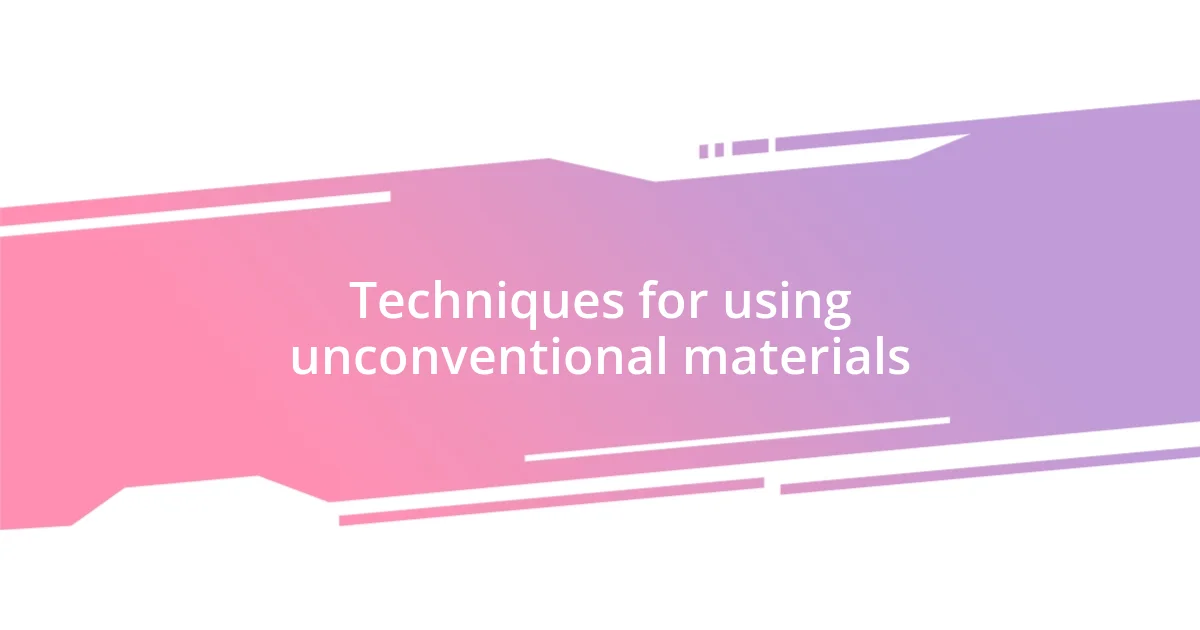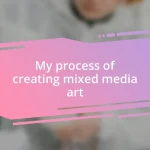Key takeaways:
- Experimenting with unconventional materials can inspire unique techniques, such as layering and using everyday objects as tools, transforming one’s artistic expression.
- Choosing the right materials involves considering factors like texture, color, availability, and environmental impact, turning mundane objects into sources of inspiration.
- Embracing mistakes and spontaneity in the creative process can lead to unexpected breakthroughs and innovative results in artistry.

Introduction to unconventional materials
When I first stumbled upon the idea of using unconventional materials for painting, I was both intrigued and a bit skeptical. Could a handful of leaves, or even coffee grounds, truly deliver the same vibrant impact as traditional paints? This curiosity ignited a journey that not only transformed my art but also reshaped my understanding of creativity.
I’ve realized that unconventional materials often inspire unique techniques. For instance, using sand gave my artwork a tactile quality that traditional acrylics could never achieve. This exploration was not just about the visuals; it became a way for me to connect with my surroundings. Imagine capturing the essence of a beach day through the grains of sand collected right on the shore. Isn’t it fascinating how such simple materials can evoke powerful memories?
Engaging with unconventional materials encouraged me to think outside the box—literally. Whether it’s using recycled paper or crushed flower petals, each medium tells a story. I often ask myself: how can the objects around me transform my artistic expression? The answers were surprising and deeply satisfying, proving that creativity knows no bounds.

Choosing the right unconventional materials
Choosing the right unconventional materials can feel like embarking on a treasure hunt. I remember one afternoon, I was in my kitchen, staring at a pile of old magazines. Suddenly, it hit me: these glossy pages could add a whole new dimension to my art! After a little experimentation, I found that the different textures and colors could transform a simple piece into something extraordinary. The thrill of discovery in using what I had on hand fueled my passion and compelled me to delve deeper into my other options.
When deciding on materials, I recommend considering the following:
- Texture: Look for items that offer varied surfaces, like fabric scraps or natural objects, for added depth.
- Color: Explore pigments from food items or natural dyes; they can provide unexpected hues.
- Availability: Choose materials that are easily sourced and resonate with you personally, like items found on your daily walks.
- Environmental impact: Recycled or biodegradable materials not only enrich your art but also promote sustainability.
By being mindful of these aspects, you can turn even the most mundane objects into your next artistic inspiration.

Techniques for using unconventional materials
Experimenting with unconventional materials can lead to some exciting techniques that transform how we approach art. One technique I loved is layering different materials. For example, I’ve used coffee grounds to create a textured background, which provided an organic feel to my landscapes. Then, I would add splashes of watercolor over it. This combination produced a rich visual depth that I never achieved with traditional methods. It’s remarkable how layering can turn a simple idea into a multi-dimensional piece full of surprises.
Another technique that I found particularly rewarding is the incorporation of everyday objects as tools. I remember using the edge of an old credit card to spread paint instead of a brush. The results were astonishing! It created sharp lines and unique textures that felt very much alive, as if the artwork was interacting with its environment. Using unconventional tools forced me to rethink the process and made the act of painting feel more playful. Have you ever considered how everyday items might redefine the way you express yourself artistically?
Lastly, I’ve discovered that embracing spontaneity can be incredibly liberating. When I painted with flower petals, the petals often fell off my canvas, creating unexpected patterns. It was in those moments of chaos that I found unexpected beauty. I began to appreciate the imperfections and unpredictability of using unconventional materials, which often led to innovative results that I never would have planned for. This experimentation infused my work with a sense of life and energy that traditional techniques sometimes lacked.
| Technique | Description |
|---|---|
| Layering | Combining different materials to create depth and texture in a piece. |
| Using Tools | Employing everyday objects to apply paint in unique ways, sparking new creative ideas. |
| Embracing Spontaneity | Allowing for accidents and surprises in the artwork to lead to unexpected results. |

Challenges faced in unconventional painting
Trying my hand at unconventional painting introduced a slew of challenges that pushed my creativity to the limits. One notable instance was when I decided to use leftover pasta as a stamp; the process was messy, and I remember feeling frustrated as the paint smeared everywhere. But that’s the nature of unconventional materials—they don’t always cooperate, and you have to adjust your expectations. Have you ever faced a situation where you felt your materials were rebelling against you?
Then there’s the issue of longevity. When I experimented with natural materials like fruit or flowers, it was a beautiful experience until I realized how quickly they deteriorated. I often found myself asking, “How do I preserve the vibrancy of my work in a world full of decay?” This posed a significant hurdle, as it meant I had to explore different sealing methods or consider the pieces’ lifespan with the right balance between beauty and durability.
Moreover, matching color schemes became a thrilling yet daunting challenge. I vividly recall my struggle to get the right shade using leftover tea and turmeric; the hues were unpredictable, often more vibrant or dull than anticipated. It made me realize the importance of being flexible and open to surprise outcomes, but it certainly tested my patience and planning skills. Isn’t it fascinating how unconventional methods can bring both joy and tension into the artistic process?

Showcasing unconventional art pieces
While showcasing unconventional art pieces, I find the right presentation can evoke strong emotions from viewers. I remember displaying a piece I created using dried leaves and twigs. When people interacted with it, I watched as their expressions shifted from curiosity to awe. It was fascinating how these natural elements sparked conversations about sustainability and the beauty of nature. Isn’t amazing how something so simple can evoke such profound reactions?
Considering the physical options for display is crucial too. I once mounted a canvas created with melted crayons in a shadow box. Not only did the vibrant colors pop, but the texture added dimension and intrigue. I noticed how viewers leaned in closer, drawn by the depth that this unconventional approach offered. It makes me wonder, could the way we display art unlock new ways for others to engage with it?
The context of the artwork also plays a pivotal role. In one memorable exhibit, I chose to hang my paintings made from recycled materials in a community center, emphasizing the theme of repurposing. I watched families pause to reflect on their own environmental impact, turning my art into a catalyst for conversation. It reminds me of the power of art to not only beautify spaces but also to challenge minds and hearts. How can we leverage our unconventional pieces to broaden the dialogue in our communities?

Tips for aspiring unconventional artists
When I started embracing unconventional materials, I quickly learned it’s all about experimentation. One piece I created involved using coffee grounds for texture. I remember the thrill of watching the textured landscape unfold on my canvas. Have you ever been so engrossed in a project that time seemed to vanish? It’s moments like these that remind us to dive deep into the process, as you might just stumble upon something magical.
Networking with other artists can truly enhance your journey. I attended a workshop where everyone brought their unconventional supplies; I still think back to a fellow artist who used soda cans to create vibrant collages. The exchange of ideas fueled my creativity and opened my mind to new possibilities. Surrounding yourself with like-minded individuals ignites a spark, don’t you think?
Lastly, don’t shy away from mistakes; they often lead to the best breakthroughs. I distinctly recall a time when I poured too much paint onto my canvas, and in frustration, I decided to turn the piece upside down. Instead of throwing it away, I ended up creating an unexpected waterfall effect that caught everyone’s eye in my studio. Embracing those moments of perceived failure can lead to incredible discoveries. How often do we let a little chaos in our creative process lead us to something extraordinary?














